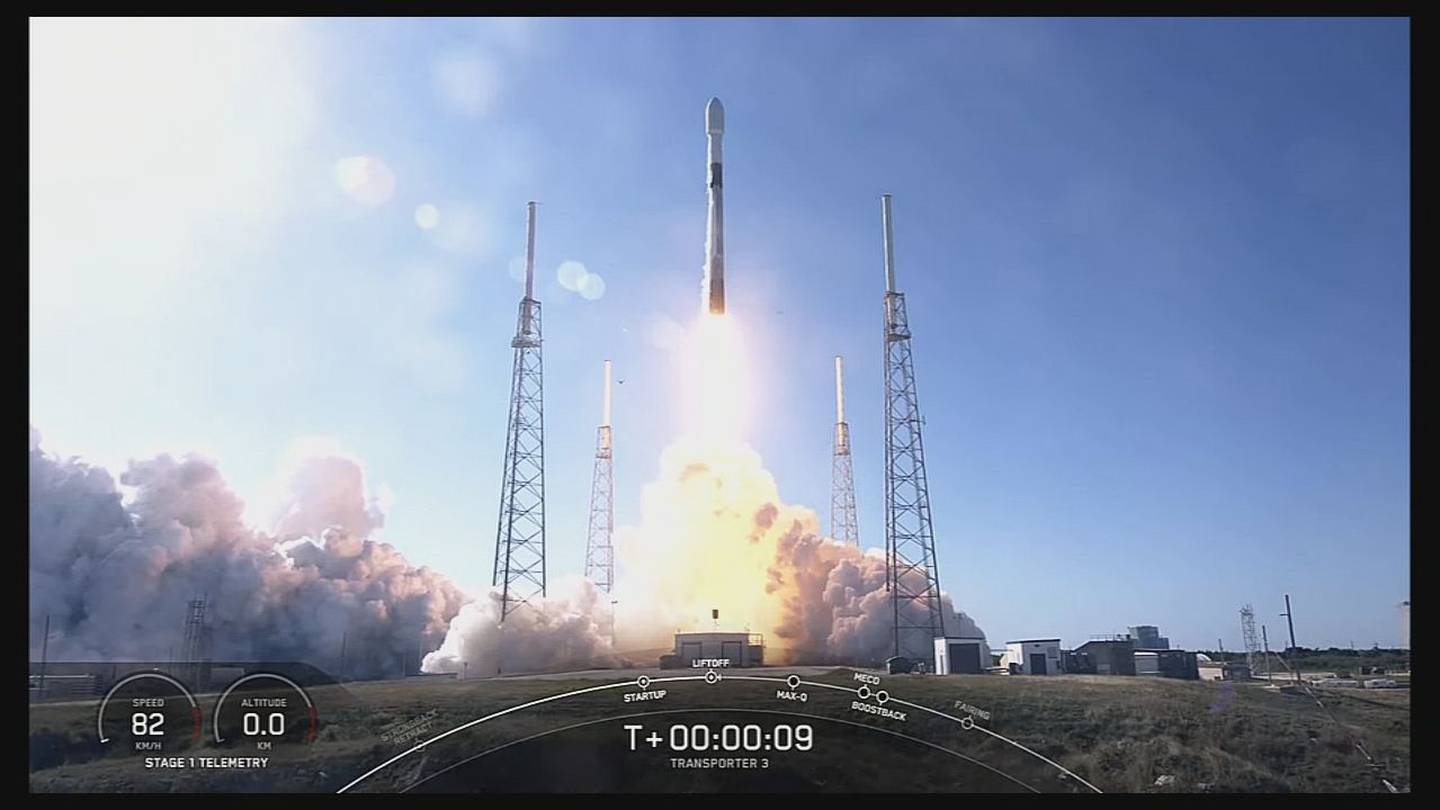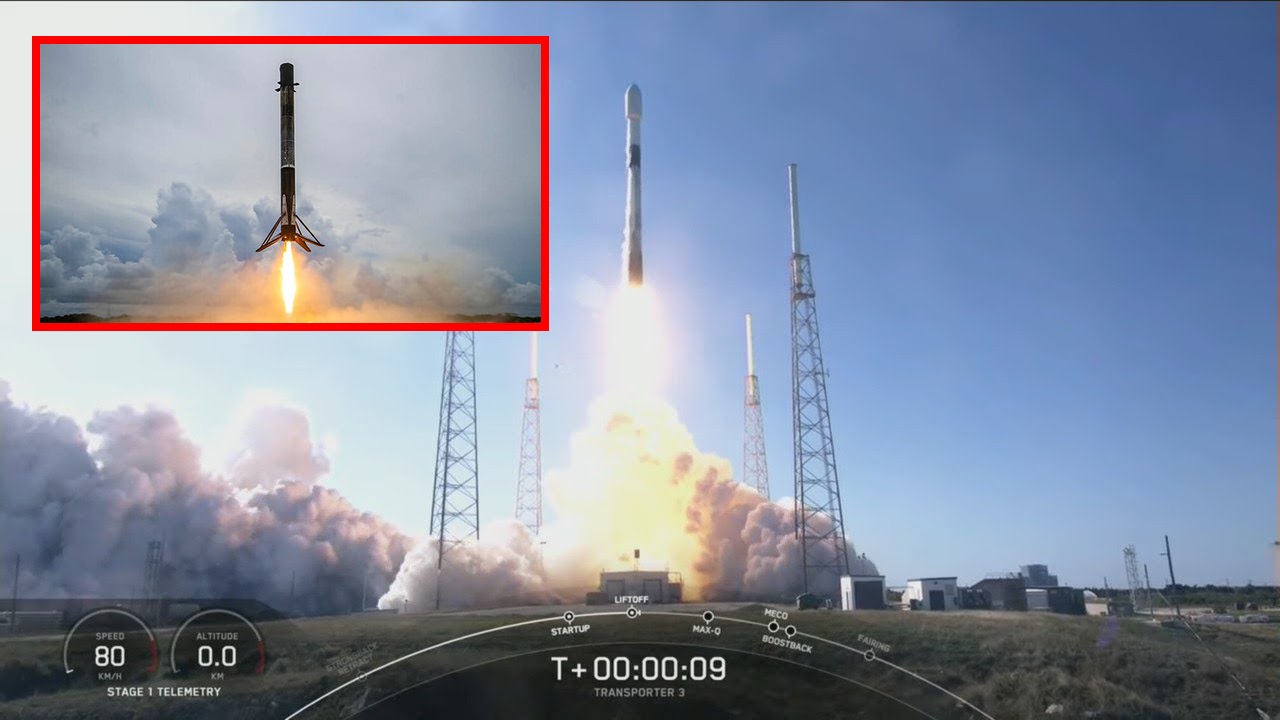SpaceX’s Transporter-3 mission was successfully completed by Falcon 9 booster B1058, acing its twelfth orbital-class launch and landing in record time.
With 105 tiny satellites in tow, the rocket launched as scheduled from Cape Canaveral Space Force Station (CCSFS) Flight Complex 40 (LC-40) on Thursday, January 13th at 10:25 a.m. EST (15:25 a.m. UTC), marking SpaceX’s third dedicated Smallsat Rideshare Program launch since January 2021.
Beginning in 2022, the company plans to launch three such rideshare launches per year, operating Falcon 9 like an orbital bus service capable of transporting hundreds of small satellites from virtually any person, institution, or company on Earth – all for an unprecedented low price of $5,000 per kilogram.
Falcon 9’s first stage has landed on Landing Zone 1 pic.twitter.com/XUQWHtB7kJ
— SpaceX (@SpaceX) January 13, 2022

As a result, it is no wonder that SpaceX’s Smallsat Rideshare Program has been so popular. With only three dedicated Transporter flights, SpaceX has already successfully carried 323 tiny satellites to orbit for 100+ clients, despite being very minor in the context of the rest of the company’s huge launch and services income.
For example, SpaceX has launched almost three times as many tiny satellites in less than a year than specialized small satellite launch business Rocket Lab has flown in the previous four years. It is little wonder, however, that after just 20 successful Electron flights, Rocket Lab has already revealed intentions to construct a far bigger, more reusable rocket.
Those two red boxes, PocketPod, carry 6x FOSSASAT-2E satellites, SANOSAT-1 from @orionspacenepal and Challenger from @quubspace https://t.co/zCdLPsyD4a
— Julian Fernandez (@EA4HCD) January 12, 2022
Meanwhile, while hundreds of other companies work on comparable tiny rockets aimed at launching about 500-1500 kg to LEO, SpaceX – which started off creating the much smaller Falcon 1 rocket – quickly abandoned small rockets to concentrate on the much bigger Falcon 9 and Falcon Heavy vehicles.
Even a modestly loaded two-stage Falcon 9 with a flight-proven rocket will almost probably cost SpaceX many times less per kilogram launched thanks to reusability than a fully-laden Falcon 1.
A good example is a rocket that launched Transporter-3. Depending on how you calculate it, the launch cost SpaceX between $15 million and $30 million to carry 105 satellites to sun-synchronous orbit, each weighing 3 to 4 tonnes (SSO).
Customers pay a set fee of $1 million for a 200 kilogram (440 lb) slot on a Transporter flight, thus a 4-ton payload might potentially bring in $20 million for SpaceX. In contrast, SpaceX sold Falcon 1 in 2005 for the equivalent of roughly $8 million today.
Falcon 1 was planned to carry 1 tonne to LEO and 400 kg to SSO. In other words, Falcon 1 customers would have paid about $20,000/kg for a space on a reusable Falcon 9, vs $5,000/kg for a slot on a Falcon 9.
A Falcon in the clouds. #Falcon9 #SpaceX
📸 for @Teslarati pic.twitter.com/MqEd1jkaPE
— Richard Angle (@RDAnglePhoto) January 13, 2022
The kicker: Transporter-3 was the ninth orbital-class flight for Falcon 9 B1058 in only 19 months, with one launch per 59 days. B1058 had actually achieved eight flights in less than a year – one launch per 45 days – until a severe slowdown in SpaceX launch activity began in mid-2021.
Transporter-3 is not even the booster’s first specialized ridesharing mission; almost a year earlier, it launched another 133 customer smallsats on Transporter-1. B1058 has also launched two astronauts, two Dragon spacecraft, a South Korean geostationary communications satellite, and around 290 Starlink spacecraft, totaling around 120 tonnes (260,000 lb) of payload delivered to orbit in a year and a half – roughly equivalent to an entire Saturn V launch to low Earth orbit for a fraction of even the marginal cost of the giant Moon rocket.
Later this year, SpaceX aims to launch two more Transporter rideshare vehicles. In the second half of January, the business has three additional Falcon 9 launches planned, including Starlink 4-6 on January 17th and Italy’s CSG-2 Earth observation satellite on January 27th. CSG-2 is planned to deploy around the same time as Starlink 4-7.
Dewa’s nanosatellite successfully launched on SpaceX rocket
Dewa-Sat 1, the world’s first nanosatellite that promotes the digitization of electricity and water networks, was successfully launched by the Dubai Electricity and Water Authority (Dewa).
This new accomplishment demonstrates Dewa’s leadership in designing and implementing cutting-edge technology.
Dewa-Sat 1 was launched from Florida’s Cape Canaveral Space Launch Complex (SLC-40) aboard a SpaceX Falcon 9 rocket. The event was attended by DEWA’s managing director and CEO, Saeed Mohammed Al Tayer, as well as Dewa and NanoAvionics executives.
“I express my gratitude to His Highness Sheikh Mohammed bin Rashid Al Maktoum, Vice-President and Prime Minister of the United Arab Emirates and Ruler of Dubai, for his unwavering support for Dewa and its innovative initiatives and projects, including the Space-D program, which His Highness launched in January 2021,” Al Tayer said. “The program intends to realize the UAE’s goal in space sciences, technology, applications, and services,” according to the National Space Strategy 2030.
Al Tayer said that the program intends to teach Emirati experts on how to utilize space technology to improve the UAE’s energy and water networks, as well as how to leverage Fourth Industrial Revolution technologies like satellite communications and earth observation to communicate information.
The nanosatellite was created and built at Dewa’s R&D Centre in the Mohammed bin Rashid Al Maktoum Solar Park, according to Al Tayer.
Dewa plans to launch another U6 nanosatellite later this year to improve its flexibility and agility in monitoring, operating and repairing its energy and water networks, according to him.
This guarantees the greatest levels of availability, dependability, and efficiency for energy and water supplies. It also saves money, makes better use of its assets, facilitates knowledge and expertise transfer, and trains Emiratis at Dewa.
Dewa-Sat 1 employs LoRa IoT communication technology to enhance the coverage of the current terrestrial communication network, according to Al Tayer. LoRa IoT communication technology is a new wireless protocol developed for long-range communications that consume less energy.
Dewa’s operations will be more efficient and effective because to the use of satellite communications, IoT, and AI, which will aid in the digitization of energy, water distribution, and transmission networks. It also allows IoT data to be integrated utilizing Dewa’s private cloud.
Dewa’s Space-D initiative involves launching the nanosatellite constellation constructed by Emiratis at the Mohammed bin Rashid Al Maktoum Solar Park, according to Waleed Bin Salman, executive vice-president of Business Development and Excellence at Dewa.
To support ground communication transmission stations in energy and water networks, the system includes a ground station at the solar park, as well as IoT and AI technologies.

